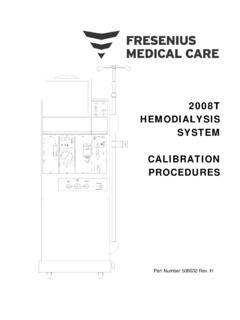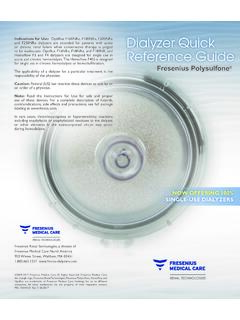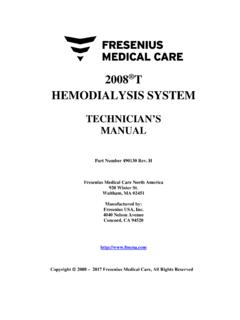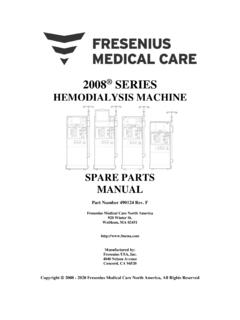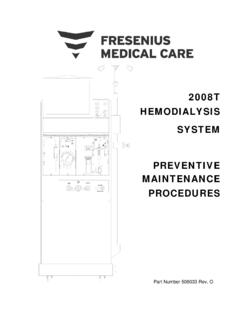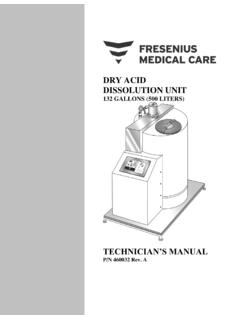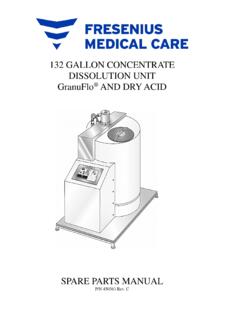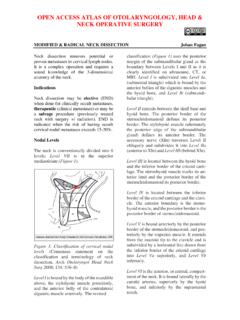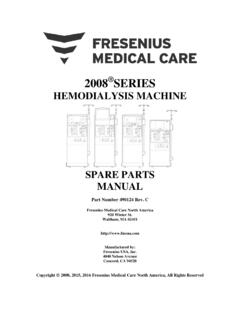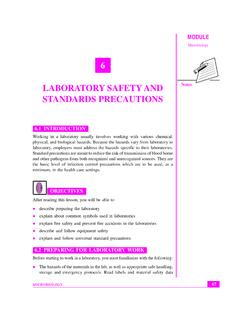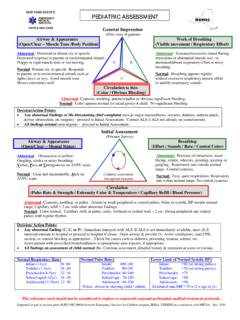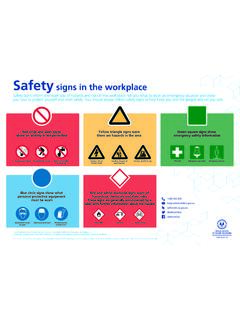Transcription of bibag V2.0 Technician’s Manual - Fresenius Medical Care
1 bibag Technician s Manual Part Number 490188 Rev. I bibag Technician s Manual Copyright 2012 2019 Fresenius Medical care , Inc. All Rights Reserved This document contains proprietary and confidential information of Fresenius USA, Inc. d/b/a Fresenius Medical care North America and its affiliates ( Fresenius Medical care ). The contents of this document may not be disclosed to third parties, copied, or duplicated in any form, in whole or in part, without the prior written permission of Fresenius Medical care . Fresenius Medical care , the triangle logo, 2008, and bibag are trademarks of Fresenius Medical care Holdings, Inc., and/or its affiliated companies. All other trademarks are the property of their respective owners. Any questions, contact Technical Support at 800-227-2572 Page 1 bibag Technician s Manual P/N 490188 Rev. I bibag Technician s Manual TABLE OF CONTENTS bibag Details.
2 2 General Warnings .. 3 Hydraulic Flow Diagram .. 4 Hydraulic Component Descriptions .. 5 Hydraulic 7 Electronic Description .. 9 Electronic Block 11 Calibrations .. 12 Annual Maintenance .. 14 Troubleshooting .. 15 Debug Screens .. 15 Spare Parts .. 15 Page 2 bibag Technician s Manual P/N 490188 Rev. I bibag Details The bibag connector is a hardware option that allows the usage of a dry bicarbonate powder to generate dialysate solution for the 2008 T and the 2008K@home hemodialysis machines. The bibag disposable is a bag filled with dry bicarbonate powder with special inlet and outlet ports. Underneath the bibag door, the bibag hangs on two nozzles, which allow for the entry of purified water and the exit of bicarbonate concentrate solution. A door handle locks the bibag door in place over the bibag disposable. Figure 1 bibag connector: door closed and bibag disposable inserted with door open Page 3 bibag Technician s Manual P/N 490188 Rev.
3 I General Warnings Warning: The concentrate displayed on the screen must match the labels on the acid container. Make certain there is enough concentrate in the containers to complete the treatment. Warning: The specific concentrate, sodium, and bicarbonate settings must be prescribed by a physician. Warning: Acid and basic bicarbonate hemodialysis concentrate must be diluted (mixed with purified water as specified in the AAMI standards for water for dialysis) immediately prior to application only. Warning: Use aseptic technique. Warning: Always verify the conductivity and approximate pH of the dialysate solution through independent means before initiating dialysis. Verify that the pH is normal and that the conductivity is reasonably close to the theoretical value. If it is not, do not initiate dialysis. Warning: Replace a leaking bibag disposable immediately. Spills can cause damage to carpeting and other surfaces.
4 To contain such spills, the machine should be on a spill-tolerant surface. Spills can cause slips and falls; clean up spills immediately. Caution: Only the bags manufactured by Fresenius Medical care may be used in the bibag connector. Note: When the bibag connector is installed, the online pressure holding test becomes mandatory. For more information, see the Online Pressure Holding Test section of the 2008 T Hemodialysis Machine Operator s Manual P/N 490122 or the 2008K@home Hemodialysis Machine Operator s Manual P/N 490180. Page 4 bibag Technician s Manual P/N 490188 Rev. I Hydraulic Flow Diagram Figure 2 Page 5 bibag Technician s Manual P/N 490188 Rev. I Hydraulic Component Descriptions 100 bibag Fill Valve The bibag fill valve opens as needed to add water to the bibag disposable during dialysis. When bibag is not used for bicarbonate during dialysis, this valve will remain closed.
5 In rinse and cleaning modes, this valve will alternate with valve 103. 101 bibag Vent Valve The bibag vent valve opens momentarily during dialysis when air is detected in the bibag air separation chamber. When bibag is not used for bicarbonate during dialysis (jug mode), this valve will open momentarily when air is detected in the bibag air separation chamber. 103 Hydrochamber Outlet Valve The hydrochamber outlet valve opens in dialysis when valve 100 is closed. In rinse and cleaning modes, this valve will alternate with valve 100. 104 Bicarbonate Port Valve Closed for bibag dialysis. Opens to empty the bibag disposable and during bibag startup. Opens when sodium bicarbonate concentrate is supplied. When sodium bicarbonate is supplied by a pressurized supply, this valve will open and close based on pressure at pressure transducer 110. 105 Acid Port Valve Used to regulate the pressure to the acid pump.
6 Will open and closed based upon pressure at pressure transducer 106. 106 Acid Port Pressure Transducer Senses pressure of the acid concentrate supply. Pressure detected from this sensor is used in conjunction with valve 105 to regulate the pressure to the acid concentrate pump. 108 Rinse Port Valve This valve is electrically in parallel with valve 104. It opens and closes at the same time as valve 104. 110 - bibag Pressure Transducer The bibag pressure transducer is used to measure the pressure inside the bibag disposable. Also used to measure the pressure of the sodium bicarbonate concentrate source when bibag is not used. 111 bibag Air Separation Chamber The bibag air separation chamber separates air from the sodium bicarbonate concentrate upon leaving the bibag disposable. It also is used to separate air from the sodium bicarbonate concentrate supplied by external sources (pre-mixed concentrates).
7 112 bibag Air Separation Chamber Air Sensor The bibag air separation chamber air sensor detects air in the air separation chamber. 113 bibag Conductivity Cell The bibag conductivity cell is used to measure the conductivity of the sodium bicarbonate concentrate leaving the bibag disposable and the conductivity of the pre-mixed concentrates. Page 6 bibag Technician s Manual P/N 490188 Rev. I Hydraulic Component Descriptions (cont.) 114 bibag Temperature Thermistor The bibag temperature thermistor is used to measure the temperature of the bicarbonate concentrate leaving the bibag disposable and the pre-mixed concentrate. 115 bibag Present Switch The bibag present switch is built into the bibag connector. The switch is positioned so that when a bibag disposable is attached to the bibag connector the switch is pressed indicating the presence of a bibag disposable. 116 Bicarbonate Temperature Thermistor Used with conductivity cell 117 to measure conductivity.
8 117 Bicarbonate Conductivity Cell Measures conductivity of the bicarbonate concentrate from the bibag disposable after it is mixed with water. 118 bibag Filter Removes any particles that may enter through the bibag disposable. bibag Connector The bibag connector holds the bag with dry bicarbonate during dialysis. The bibag connector incorporates a three position door (see Figure 3). The door may be placed in the position open, operating, or bypass. In the open position (1) and (4), a bibag disposable may be installed or removed from the connector. The operating position (5) is used when a bibag disposable is installed for dialysis. The bypass position (3) is the completely closed position (not possible if a bag is hanging from the connector). The door must be in the closed position (3) for rinse, cleaning, and jug dialysis mode. Position (2) should not be used. Figure 3 3 2 4 5 bibag disposable 1 Door Page 7 bibag Technician s Manual P/N 490188 Rev.
9 I Hydraulic Operation Dialysis with bibag Heated water from chamber E of the hydrochamber flows to the junction of valves 100 and 103. Valve 100 opens and the bibag disposable will start filling when the dialysate temperature at temperature sensor 3 reaches 30 degrees C. Valve 100 will close when the pressure reaches 150mmHg as monitored by the pressure transducer 110. After this initial fill, valves 104 and 108 open, valve 103 closes, the balancing chamber valves open and any excess gas generated in the bag is flushed through the hydraulics down the drain. The flow pump runs and the machine is kept in bypass during this initial flush. Afterwards, additional water will be added to the bag to maintain pressure in the bag of about 90mmHg. The conductivity cell (113) and temperature sensor (114) measure the conductivity and temperature of the sodium bicarbonate concentrate as it leaves the bag. The temperature compensated conductivity determines the concentration of the sodium bicarbonate concentrate and the delivery rate of the bicarbonate pump (17).
10 If air is sensed by the probes (112) in the air separation chamber, valve 101 is momentarily opened to vent the air. If the pressure in the bibag disposable does not change while the bicarbonate pump is pumping, an airlock condition is detected. To remove the airlocked condition in the bicarbonate pump, valve 100 opens to pressurize the bag to 150mmHg. Next, the flow is stopped, the balance chamber valves are opened up, the flow pump runs, and the machine is kept in bypass. Conductivity cell 117 checks the amount of sodium bicarbonate added to the dialysate and a conductivity alarm will be displayed if the solution is not within: 5% of expected in Functional board software version less than 15% of expected in Functional board software version or greater. Dialysis with Sodium Bicarbonate Concentrates Jug bicarbonate dialysis is also supported with the bibag hydraulics. To run in this mode, the bibag connector door must be completely closed and the bicarbonate connector pulled out.

